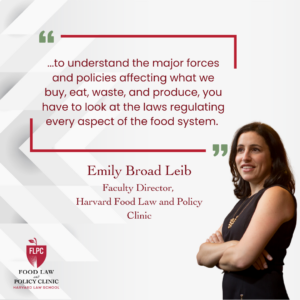This blog post was written by Sophie DeBode, a student in the Food Law and Policy Clinic.
The Inflation Reduction Act, signed August 16, 2022, provides roughly $369 billion in funding to invest in climate solutions and environmental justice. This Act will put the U.S. on a path to 40% emissions reductions by 2030. One major contributor to climate change is food waste. Food waste is responsible for over 8% of global greenhouse gas emissionsand generates about 270 million metric tons of CO2 equivalent greenhouse gas emissions each year—the same as 58 million passenger vehicles. Food waste is an often overlooked contributor to climate change, but reducing food waste represents a tremendous opportunity to cut down on greenhouse gas emissions and should be included in climate change solutions whenever possible.
While no portion of the Act directly addresses food waste, some of the investments directed towards climate issues can and should be used to target food waste, as noted by other food system advocates. Specifically, the Act creates three new programs: the Greenhouse Gas Air Pollution Planning Grants (Planning Grants), the Greenhouse Gas Air Pollution Implementation Grants (Implementation Grants), and the Greenhouse Gas Reduction Fund, all of which can be used to fund projects to prevent food waste or facilitate the recycling of food scraps. This blog will first explain these programs, then suggest how they can be leveraged for food waste reduction, and end with a brief outline next steps for those interested in applying for these grants.
Inflation Reduction Act Programs
Greenhouse Gas Air Pollution Planning Grants and Greenhouse Gas Air Pollution Reduction Implementation Grants (Section 60114)
The Act allocates $250 million forthe Planning Grants and $4.75 billion for the Implementation Grants. The Planning Grants gives the Environmental Protection Agency (EPA) funding for grants to states, air pollution control agencies, municipalities, and Indian tribes to develop a plan to reduce greenhouse gas air pollution. The Implementation Grants Program provides that the EPA will competitively award grants to implement plans developed under the Planning Grants. Applications will need to include information regarding the degree to which greenhouse gas is projected to be reduced in total and with respect to low-income and disadvantaged communities. The EPA will provide specific requirements for how eligible entities are able to apply and what additional information they will need to provide.
Greenhouse Gas Reduction Fund (Section 60103)
The Act allocates $27 billion to a Greenhouse Gas Reduction Fund that will be administered by the EPA. However, the funding will be given as financing (to be repaid), rather than grants. The funding will be given to eligible recipients which are limited to publicly or charitably funded nonprofit organizations that are designed to provide capital or financial assistance for deployment of low- and zero- emissions products, technologies, and services. To receive this funding, projects, activities, or technologies must:
- Reduce or avoid greenhouse gas emissions or other forms of air pollution in partnership with, and by leveraging investment from, the private sector; or
- Assist communities in their efforts to reduce or avoid greenhouse gas emissions and other forms of pollution.
There are two streams of funding that could be used for food waste reduction by financing qualified projects (those that meet the above requirements) focusing on food waste reduction as a means to reduce greenhouse gas emissions. The first is funding for General Assistance. Subsection A(2) appropriates $11.97 billion through September 2024 to support eligible entities making direct and indirect investments in qualified projects nationwide. The second is funding for Low-income and Disadvantaged Communities. Subsection A(3) appropriates $8 billion through 2024 to support eligible entities providing financial and technical assistance for qualified projects in low-income and disadvantaged communities.
Applicability to Food Waste
Since food waste is a major contributor to greenhouse gas emissions, eligible entities can and should use funding from these programs to implement projects that develop infrastructure to reduce food waste, and consequently reduce greenhouse gas emissions. Examples of such infrastructure/programs include organic waste bans, organic waste processing infrastructure, food recovery infrastructure, and food procurement programs.
Organic waste bans: organic waste bans have the potential to significantly reduce the volume of food waste that goes to landfills and accordingly reduce greenhouse gases. The funding from the programs established by the Act could be used to help eligible entities implement organic waste bans by funding measurement practices (such as waste measurement and characterization studies), supporting alternative disposal or reduction methods (e.g., composting facilities, anaerobic digestors, food donation programs), and promoting education and awareness efforts.
Organic waste processing infrastructure: compost programs, anaerobic digestion infrastructure, and animal feed facilities have the potential to convert food waste into productive soil amendments or sustainable animal feed. The funding from the Act’s greenhouse gas programs, either in the form of grants or financing, could be used to help eligible entities develop organic waste processing infrastructure and facilities, such as anaerobic digestion facilities which can process around 50,000 tons of waste per year, to divert food from landfills to higher uses.
Food recovery infrastructure: improving donation transportation and storage infrastructure has the potential to divert 908,000 tons of food waste and reduce 1.316 million metric tons of CO2e, but currently costs and logistical challenges make it difficult for food producers and vendors to donate surplus food. The Act’s funding programs could be used to invest in the development of food recovery infrastructure which will ensure that food that would otherwise go to waste, and contribute to greenhouse gas emissions, can instead by redirected to food insecure individuals. This solution addresses issues of food waste, climate change, and food insecurity.
Food procurement programs: states and municipalities could use the funding from the Act’s programs to develop procurement programs to recover unharvested, perishable produce from farms to both prevent food and provide food to food insecure individuals. This funding could be used for the harvesting, processing, packaging, and transporting the food.
FLPC’s Opportunities to Reduce Food Waste in the 2023 Farm Bill Report further explains these food waste reductions programs as well as many others.
Next Steps
The EPA, the agency that will be administering these programs, has not yet made any announcements regarding how and when eligible entities should apply for funding. However, the Act specifies that for the Greenhouse Gas Air Pollution Planning and Implementation Grants, the EPA must publish a funding opportunity announcement for these grants within 270 days of enactment (which means the announcement will be published on or before May 13, 2023). For the Greenhouse Gas Reduction Fund, both the General Assistance and Low-income and Disadvantaged Communities funding streams, the EPA must begin making these grants 180 days after enactment—by February 12, 2023. Interested parties should be sure to monitor EPA announcements as these deadlines approach.
When it is eventually made available, all information will likely be provided by the EPA’s Office of Air and Radiation (OAR) which announces all competitive funding for projects and programs related to air quality, transportation, climate change, and related topics. OAR provides an Application Kit on their site to assist eligible entities in applying for relevant grants.


Health Law & Policy, Commentary
Braidwood Management v. Becerra: Updated FAQs for Health Advocates and Providers
July 22, 2024